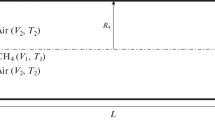Abstract
Calculation results are presented for laminar and turbulent boundary-layer flows on a porous plate with methane injection and combustion. The mathematical model is based on the boundary-layer approximation. Combustion was simulated by one global finite-rate reaction and the kinetic mechanism of hydrogen and carbon oxide afterburning. It is shown that injection and combustion in laminar and turbulent flows lead to more intense displacement of the flow away from the wall than in the case of injection into an isothermal flow, which decreases the friction drag and heat and diffusion fluxes. Combustion in a turbulent flow leads to flow laminarization and delay of the laminar–turbulent transition.
Similar content being viewed by others
REFERENCES
V. B. Amfilokhiev, L. S. Artyushkov, B. A. Barbanel', A. I. Korotkin, K. M. Mazaev, L. I. Mal'tsev, and B. N. Semenov, State-of-the-Art of the Boundary-Layer Control Theory [in Russian], Sea Machine Building Bureau “Malakhit,” St. Petersburg (2000).
A. V. Kazakov, M. N. Kogan, and A. P. Kuryachii, “Effect of local heat addition to a turbulent boundary layer on friction,” Izv. Ross. Akad. Nauk, Mekh. Zhidk. Gaza, No. 1, 48–56 (1997).
É. P. Volchkov, V. V. Terekhov, and V. I. Terekhov, “Boundary-layer structure with hydrogen combustion with different injection intensities,” Combust. Expl. Shock Waves, 38, No. 3, 269–277 (2002).
B. F. Boyarshynov, E. P. Volchkov, and V. I. Terekhov, “Flow structure and heat and mass transfer in a boundary layer with ethanol combustion,” in: Flame Structure (collected scientific papers) [in Russian], Vol. 1, Nauka, Novosibirsk (1991), pp. 141–146.
É. P. Volchkov, N. A. Dvornikov, and L. N. Perepechko, “Mathematical simulation of turbulent combustion of ethanol near a permeable surface,” in: Heat and Mass Transfer MMF-96, Proc. IIIrd Minsk Int. Forum on Heat and Mass Transfer [in Russian], Vol. 1, Part 1, Minsk (1996), pp. 74–78.
C. K. G. Lam and K. A. Bremhorst, “Modified form of the (k–ε)-model predicting wall turbulence,” J. Fluids Eng., 103, 456–460 (1981).
Yu. V. Lapin and M. Kh. Strelets, Internal Flows of Gas Mixtures [in Russian], Nauka, Moscow (1989).
É. P. Volchkov, N. A. Dvornikov, and L. N. Perepechko, “Comparison of different methods of modeling turbulent combustion in a boundary layer,” Combust. Expl. Shock Waves, 32, No. 4, 390–394 (1996).
S. Oka, M. Sijercic, P. Stefanovic, et al., “Mathematical modeling of complex turbulent flows (Recent achievements of the Vincha institute),” Russian J. Eng. Thermophys., 4, No. 3, 245–284 (1994).
S. V. Patankar and D. B. Spalding, Heat and Mass Transfer in Boundary Layers, Intertext Books, London (1970).
S. F. Gross, J. P. Hartnett, D. J. Masson, and C. Gazley, Jr., “A review of boundary binary layer characteristics,” Project RAND, Research Memorandum, RN-2516 (1959).
T. Cebici and P. Bradshaw, Physical and Computational Aspects of Convective heat Transfer, Springer Verlag (1984).
V. M. Eroshenko and L. I. Zaichik, Hydrodynamics and Heat and Mass Transfer on Permeable Surfaces [in Russian], Nauka, Moscow (1984).
É. P. Volchkov and L. N. Perepechko, “Investigation of heat-and mass-transfer processes in the boundary layer with injection and evaporation,” in: Heat and Mass Transfer MMF-2000, Proc. IVth Minsk Int. Forum, Vol. 1, Minsk (2000), pp. 408–415.
E. P. Dyban, É. Ya. Épik, and T. T. Suprun, “Special features of heat transfer in the region of the laminar—turbulent transition with an elevated level of flow turbulence,” in: Heat and Mass Transfer MMF-96, Proc. IIIrd Minsk Int. Forum on Heat and Mass Transfer, Vol. 1, Part 2, Minsk (1996), pp. 112–116.
Author information
Authors and Affiliations
Rights and permissions
About this article
Cite this article
Perepechko, L.N. Numerical Study of the Effect of Methane Combustion on Heat and Mass Transfer and Friction in the Boundary Layer. Combustion, Explosion, and Shock Waves 39, 255–260 (2003). https://doi.org/10.1023/A:1023831900871
Issue Date:
DOI: https://doi.org/10.1023/A:1023831900871




